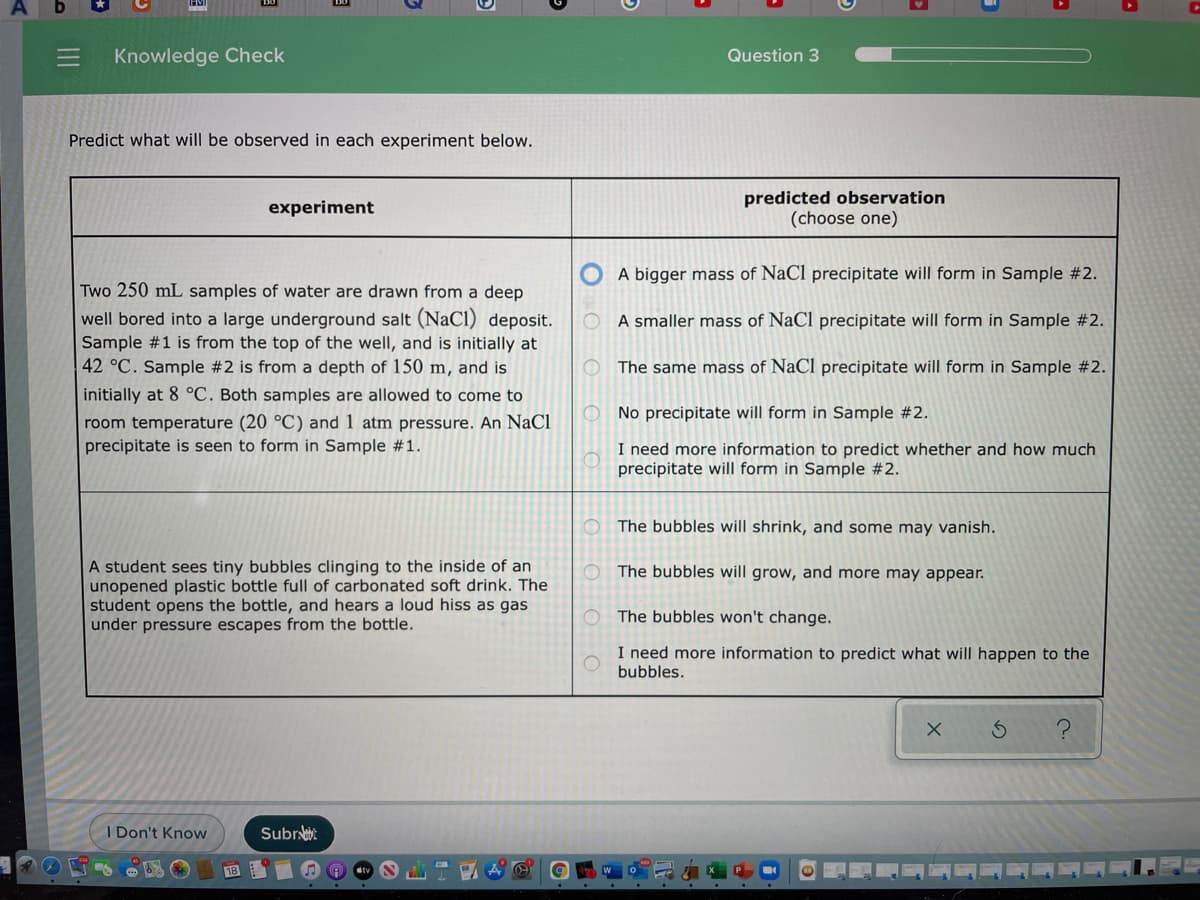Knowledge Check Question 3 Predict what will be observed in each experiment below. predicted observation (choose one) experiment A bigger mass of NaCl precipitate will form in Sample #2. Two 250 mL samples of water are drawn from a deep well bored into a large underground salt (NaCl) deposit. Sample #1 is from the top of the well, and is initially at 42 °C. Sample #2 is from a depth of 150 m, and is A smaller mass of NaCl precipitate will form in Sample #2. O The same mass of NaCl precipitate will form in Sample #2. initially at 8 °C. Both samples are allowed to come to room temperature (20 °C) and 1 atm pressure. An NaCI precipitate is seen to form in Sample #1. O No precipitate will form in Sample #2. I need more information to predict whether and how much precipitate will form in Sample #2. The bubbles will shrink, and some may vanish. A student sees tiny bubbles clinging to the inside of an unopened plastic bottle full of carbonated soft drink. The student opens the bottle, and hears a loud hiss as gas under pressure escapes from the bottle. O The bubbles will grow, and more may appear. O The bubbles won't change. I need more information to predict what will happen to the bubbles. III
Knowledge Check Question 3 Predict what will be observed in each experiment below. predicted observation (choose one) experiment A bigger mass of NaCl precipitate will form in Sample #2. Two 250 mL samples of water are drawn from a deep well bored into a large underground salt (NaCl) deposit. Sample #1 is from the top of the well, and is initially at 42 °C. Sample #2 is from a depth of 150 m, and is A smaller mass of NaCl precipitate will form in Sample #2. O The same mass of NaCl precipitate will form in Sample #2. initially at 8 °C. Both samples are allowed to come to room temperature (20 °C) and 1 atm pressure. An NaCI precipitate is seen to form in Sample #1. O No precipitate will form in Sample #2. I need more information to predict whether and how much precipitate will form in Sample #2. The bubbles will shrink, and some may vanish. A student sees tiny bubbles clinging to the inside of an unopened plastic bottle full of carbonated soft drink. The student opens the bottle, and hears a loud hiss as gas under pressure escapes from the bottle. O The bubbles will grow, and more may appear. O The bubbles won't change. I need more information to predict what will happen to the bubbles. III
Chemistry
10th Edition
ISBN:9781305957404
Author:Steven S. Zumdahl, Susan A. Zumdahl, Donald J. DeCoste
Publisher:Steven S. Zumdahl, Susan A. Zumdahl, Donald J. DeCoste
Chapter1: Chemical Foundations
Section: Chapter Questions
Problem 1RQ: Define and explain the differences between the following terms. a. law and theory b. theory and...
Related questions
Question

Transcribed Image Text:Knowledge Check
Question 3
Predict what will be observed in each experiment below.
predicted observation
(choose one)
experiment
A bigger mass of NaCl precipitate will form in Sample #2.
Two 250 mL samples of water are drawn from a deep
well bored into a large underground salt (NaCI) deposit.
Sample #1 is from the top of the well, and is initially at
42 °C. Sample #2 is from a depth of 150 m, and is
A smaller mass of NaCl precipitate will form in Sample #2.
The same mass of NaCl precipitate will form in Sample #2.
initially at 8 °C. Both samples are allowed to come to
No precipitate will form in Sample #2.
room temperature (20 °C) and 1 atm pressure. An NaCl
precipitate is seen to form in Sample #1.
I need more information to predict whether and how much
precipitate will form in Sample #2.
O The bubbles will shrink, and some may vanish.
A student sees tiny bubbles clinging to the inside of an
unopened plastic bottle full of carbonated soft drink. The
student opens the bottle, and hears a loud hiss as gas
under pressure escapes from the bottle.
The bubbles will grow, and more may appear.
O The bubbles won't change.
I need more information to predict what will happen to the
bubbles.
I Don't Know
Subrt
Expert Solution
This question has been solved!
Explore an expertly crafted, step-by-step solution for a thorough understanding of key concepts.
This is a popular solution!
Trending now
This is a popular solution!
Step by step
Solved in 2 steps

Knowledge Booster
Learn more about
Need a deep-dive on the concept behind this application? Look no further. Learn more about this topic, chemistry and related others by exploring similar questions and additional content below.Recommended textbooks for you

Chemistry
Chemistry
ISBN:
9781305957404
Author:
Steven S. Zumdahl, Susan A. Zumdahl, Donald J. DeCoste
Publisher:
Cengage Learning

Chemistry
Chemistry
ISBN:
9781259911156
Author:
Raymond Chang Dr., Jason Overby Professor
Publisher:
McGraw-Hill Education

Principles of Instrumental Analysis
Chemistry
ISBN:
9781305577213
Author:
Douglas A. Skoog, F. James Holler, Stanley R. Crouch
Publisher:
Cengage Learning

Chemistry
Chemistry
ISBN:
9781305957404
Author:
Steven S. Zumdahl, Susan A. Zumdahl, Donald J. DeCoste
Publisher:
Cengage Learning

Chemistry
Chemistry
ISBN:
9781259911156
Author:
Raymond Chang Dr., Jason Overby Professor
Publisher:
McGraw-Hill Education

Principles of Instrumental Analysis
Chemistry
ISBN:
9781305577213
Author:
Douglas A. Skoog, F. James Holler, Stanley R. Crouch
Publisher:
Cengage Learning

Organic Chemistry
Chemistry
ISBN:
9780078021558
Author:
Janice Gorzynski Smith Dr.
Publisher:
McGraw-Hill Education

Chemistry: Principles and Reactions
Chemistry
ISBN:
9781305079373
Author:
William L. Masterton, Cecile N. Hurley
Publisher:
Cengage Learning

Elementary Principles of Chemical Processes, Bind…
Chemistry
ISBN:
9781118431221
Author:
Richard M. Felder, Ronald W. Rousseau, Lisa G. Bullard
Publisher:
WILEY